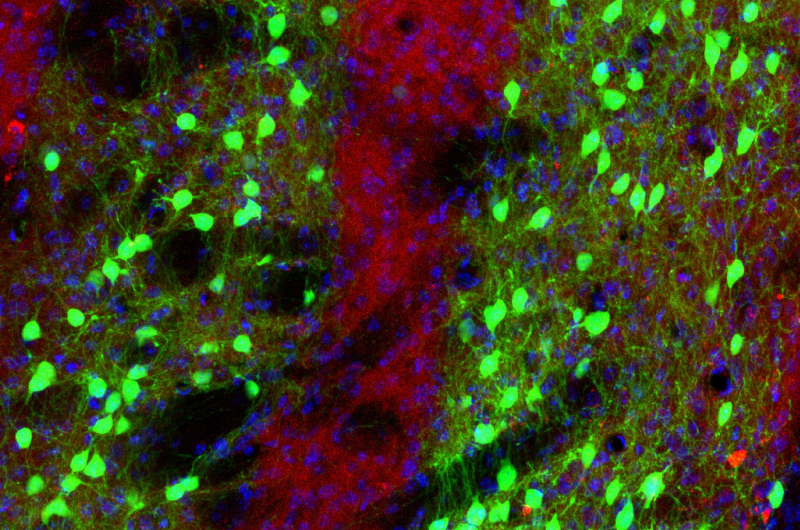Salk Institute researchers employed novel genetic tools to map theconnectivity of neurons within a part of the brain, called the striatum,which controls movement toward a goal or reward. The matrix neurons,highlighted in green, appear to avoid the patch neurons (red), which aresmaller clusters of neurons in the striatum. The functions of matrix andpatch neurons are still unknown, but the new research will allowscientists to better understand their connections and control the activityof these neurons in future studies. Credit: Salk Institute
When you reach for that pan of brownies, a ball-shaped brain structure called the striatum is critical for controlling your movement toward the reward. A healthy striatum also helps you stop yourself when you've had enough.
But when the striatum doesn't function properly, it can lead to disorders such as Parkinson's disease, obsessive-compulsive disorder or addiction.
In fact, the exact functions of the striatum are by no means resolved, and it's also a mystery how the structure can coordinate many diverse functions. Now, a new study published August 25, 2016 by Salk Institute researchers and their colleagues in the journal Neuron, delves into the anatomy and function of the striatum by employing cutting-edge strategies to comprehensively map one of the brain's lesser-known forms of organization.
"The most exciting result from this research is that we now have a new avenue to study long-standing questions about how the striatum controls movement in both healthy and diseased brains," says the study's senior investigator Xin Jin, an assistant professor in the Molecular Neurobiology Laboratory at Salk.
Forty years ago, researchers discovered a unique way that the striatum is organized. It is dotted with patch neurons, which under the microscope look like tiny islands of cells. The ocean surrounding them is made up of neurons scientists collectively refer to as "matrix" cells.
Over the course of four decades, scientists hypothesized about the role of patch and matrix neurons in neurodegenerative diseases. One idea was that patch cells were fed by the brain's higher thought centers, suggesting they could play a role in cognition, whereas the matrix cells seemed to play a role in sensing and movement.
In contrast, the new study dispels that idea, showing that both types of information are sent to the patch and matrix neurons, though patch cells tend to receive slightly more information from the brain's emotion centers (these are included in the higher thought centers). But those results could help explain why, in the brains of patients with neurological disorders like Huntington's disease (a progressive neurodegenerative disease affecting movement and other functions), patch cells and matrix cells are both affected, Jin says.
Jin, together with the paper's first authors Jared Smith, Jason Klug and Danica Ross, drew upon several technologies to uncover these new findings. The first was genetic engineering to selectively and precisely target the patch versus matrix neurons; traditionally, researchers used staining methods that were not as exact. Secondly, new neural tracing methods, including one generated by collaborator Edward Callaway and his group at Salk, allowed Jin's team to chart the entire brain's input to the patch and matrix cells and the output of each of the cell types as well. A third major approach, from the field of electrophysiology, enabled the scientists to confirm the connections they had mapped and to understand their strength.
"Much of the previous work on patch and matrix cells inferred their functions based on connectivity with the rest of the brain, but most of those hypotheses were incorrect," Smith says. "With a more precise map of the input and output of patch and matrix cells, we can now make more informed hypotheses."
Patch and matrix neurons are not the only way that neuroscientists understand the striatum. The striatum also contains cells that take two opposing routes—the direct and indirect pathways—that are thought to provide the gas and brakes on movement, so to speak. Those indirect and direct pathways are also crucial for certain behaviors, such as the formation of new habits.
Interestingly, both patch and matrix groups contain both indirect and direct pathway cells. That makes the story of the striatum more complicated, Jin says, but in future studies his team can study the intersection of these two types of organization in the context of how the striatum controls actions in health and disease.
Journal information: Neuron
Provided by Salk Institute























